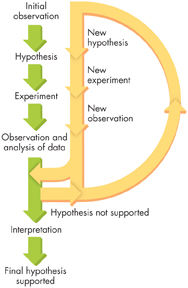Drawing Conclusions Scientists use experimental data as evidence to support, refute, or revise the hypothesis being tested, and to draw a valid conclusion. Hypotheses are often not fully supported or refuted by one set of experiments. Rather, new data may indicate that the researchers have the right general idea but are wrong about a few particulars. In that case, the original hypothesis is reevaluated and revised; new predictions are made, and new experiments are designed. Those new experiments might suggest changes in the experimental treatment or better control of more variables. As shown in Figure 1–4, many circuits around this loop are often necessary before a final hypothesis is supported and conclusions can be drawn.
When Experiments Are Not Possible It is not always possible to test a hypothesis with an experiment. In some of these cases, researchers devise hypotheses that can be tested by observations. Animal behavior researchers, for example, might want to learn how animal groups interact in the wild. Investigating this kind of natural behavior requires field observations that disturb the animals as little as possible. When researchers analyze data from these observations, they may devise hypotheses that can be tested in different ways.
Sometimes, ethics prevents certain types of experiments—especially on human subjects. Medical researchers who suspect that a chemical causes cancer, for example, would not intentionally expose people to it! Instead, they search for volunteers who have already been exposed to the chemical. For controls, they study people who have not been exposed to the chemical. The researchers still try to control as many variables as possible. For example, they might exclude volunteers who have serious health problems or known genetic conditions. Medical researchers always try to study large groups of subjects so that individual genetic differences do not produce misleading results.

FIGURE 1–4 Revising Hypotheses During the course of an investigation, hypotheses may have to be revised and experiments redone several times.
d1.1 Assessment

-
Review What is science?
Explain What kinds of understandings does science contribute about the natural world?
Form an Opinion Do you think that scientists will ever run out of things to study? Explain your reasoning.
-
Review What does scientific methodology involve?
Explain Why are hypotheses so important to controlled experiments?
WRITE ABOUT SCIENCE
A few hundred years ago, observations seemed to indicate that some living things could just suddenly appear: maggots showed up on meat; mice were found on grain; and beetles turned up on cow dung. Those observations led to the incorrect idea of spontaneous generation—the notion that life could arise from nonliving matter. Write a paragraph for a history magazine evaluating the spontaneous generation hypothesis. Why did it seem logical at the time? What evidence was overlooked or ignored?

Table of Contents
- Formulas and Equations
- Applying Formulas and Equations
- Mean, Median, and Mode
- Estimation
- Using Measurements in Calculations
- Effects of Measurement Errors
- Accuracy
- Precision
- Comparing Accuracy and Precision
- Significant Figures
- Calculating With Significant Figures
- Scientific Notation
- Calculating With Scientific Notation
- Dimensional Analysis
- Applying Dimensional Analysis




